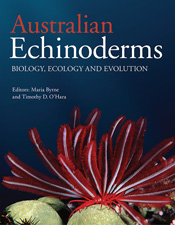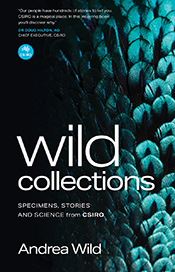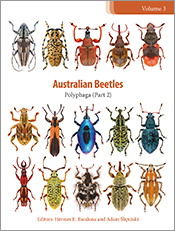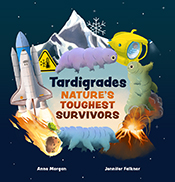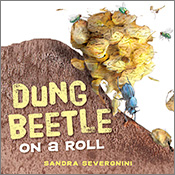Australian Echinoderms

Biology, Ecology and Evolution
Edited by: Maria Byrne, Timothy D O'HaraA comprehensive, illustrated resource for the identification, evolution and ecology of echinoderms.
Echinoderms, including feather stars, seastars, brittle stars, sea urchins and sea cucumbers, are some of the most beautiful and interesting animals in the sea. They play an important ecological role and several species of sea urchins and sea cucumbers form the basis of important fisheries. Over 1000 species live in Australian waters, from the shoreline to the depths of the abyssal plain and the tropics to Antarctic waters. + Full description
Australian Echinoderms is an authoritative account of Australia’s 110 families of echinoderms. It brings together in a single volume comprehensive information on the identification, biology, evolution, ecology and management of these animals for the first time. Richly illustrated with beautiful photographs and written in an accessible style, Australian Echinoderms suits the needs of marine enthusiasts, academics and fisheries managers both in Australia and other geographical areas where echinoderms are studied.
Winner of the 2018 Whitley Medal
- Short descriptionNews
Co-published with the Australian Biological Resources Study (ABRS).
Reviews
"This book is a magnificent collation of information and is a one-stop-shop for all things Echinoderm. The editors Maria Byrne and Tim O’Hara have done a marvellous job compiling such a vast amount of knowledge and literature. This is a must-have book for all those interested in Echinoderms and I would give it five out of five sea stars!"
Joel Williams, Australian Marine Science Bulletin 201(3), December 2017
"Maria Byrne and Tim O'Hara (and a distinguished cast of international contributors) have used all of those features of echinoderm diversity to produce a beautifully illustrated volume that is part textbook, part field guide, and part coffee-table book... researchers and invertebrate zoology teachers will highly value owning a copy of Australian Echinoderms. I consider mine a treasure."
Michael W. Hart, Invertebrate Biology, November 2018
"I am probably one of the few who has dedicated two years to studying a particular echinoderm, and I am often questioned about why I would choose to spend so much time looking at a spikey rock. But to me, echinoderms are really quite special, and this book does a far better job of explaining the incredible nature of these unusual animals than I ever will."
Trish Koh, Remember the Wild (blog), 15 May 2018
"The editors need to be congratulated for such a comprehensive account of echinoderms which I know has had a very long gestation and been a labour of love, and this book needs to be available in all marine biology departments. While the focus is on the Australian fauna it is relevant to anybody studying this group anywhere in the world and I cannot think of anything else like it, certainly not in terms of its comprehensiveness."
Pat Hutchings, Pacific Conservation Biology 24(1), 2018
"[Australian Echinoderms] is packed full of information and beautifully illustrated. The volume has layers of information, beginning with general and introductory sections and then expands into increasing detail and specialization making it useful for a range of readers from students to amateur naturalists to specialist scientists... This is an extraordinarily comprehensive reference that is beautifully presented. It reminds us why even today we still want and need to have printed monographs on our bookshelves."
John Keesing, The Quarterly Review of Biology 93, September 2018
"Filled to the brim with beautifully illustrated essays on starfish, sea urchins, and allies, the book invites to settle down and delve into it immediately. The contents do not disappoint... a wonderful introduction into many different aspects of echinoderm biology and the Australian echinoderm fauna... No matter if the reader is an undergraduate student or fully established echinoderm researcher, I am confident he or she will discover novel and surprising facts, even if they have been studying echinoderms for many years like myself."
Andreas Koh, Bulletin of Marine Science 94(4), 2018
Details
Hardback | June 2017 | $180.00ISBN: 9781486307623 | 624 pages | 270 x 210 mm
Publisher: CSIRO Publishing
Colour photographs, Illustrations
ePDF | June 2017
ISBN: 9781486307630
Publisher: CSIRO Publishing
Available from eRetailers
ePUB | June 2017
ISBN: 9781486307647
Publisher: CSIRO Publishing
Available from eRetailers
Features
- Covers each of the 110 echinoderm families found in Australia
- Over 700 stunning colour photographs
- Provides comprehensive detail about echinoderm identification, biology, evolution, ecology and management
Contents
ForewordContents at a glance
Extended Contents
Editors and Contributors
Contributors
Illustrators and Photographers
Part 1: Introduction to Echinoderms
1: Introduction
2: Ecology and Behaviour
3: Echinoderm Life Histories
4: Management: Fisheries, Ferals and Conservation
5: Biogeography
6: Phylogeny and Geological History
Part 2: Echinoderm Diversity
7: Class CRINOIDEA
8: Class ASTEROIDEA
9: Class OPHIUROIDEA
10: Class ECHINOIDEA
11: Class HOLOTHUROIDEA
References
Index
View the full table of contents.
Authors
Maria Byrne is Professor of Marine and Developmental Biology at the University of Sydney. Her research interests are on the biology, ecology, conservation and evolution in marine invertebrates with a focus on echinoderms from across the globe and more recently on the impacts of climate change.
Timothy O'Hara has been researching echinoderms since high school. Since becoming a curator at Museums Victoria in 2001, his research has focused on using the vast amounts of data and specimens stored in museum collections to address issues of biodiversity conservation and management. He has conducted biodiversity and ecological surveys, mapped the distribution of seafloor animals across oceans, used extracted DNA to study evolution, and described many beautiful new species.
Australian Biological Resources Study (ABRS)
In 1973 the Commonwealth Government established the Australian Biological Resources Study to document what plants and animals there are in Australia and where they occur. The ABRS is now part of the Department of the Environment. It brings together the expertise of scientists from around Australia and overseas, to prepare and publish authoritative information about Australia’s flora and fauna.

